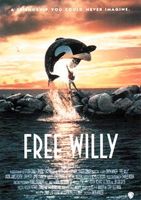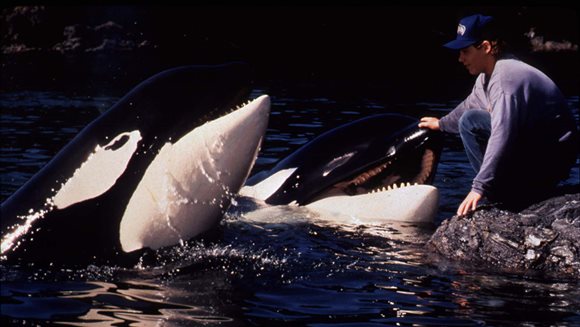
Famed for its CGI clip of a killer whale jumping over a wall into freedom, family film Free Willy follows a young boy’s transformation from “street kid” to animal activist after forming a bond with hostile orca Willy. 12 year old Jesse’s bond enables him to train and care for the three ton orca, which several trainers have struggled to do as he is “a case”. However, their bond experiences turbulence when the marina’s owners plan to kill Willy in order to claim insurance; with Jesse then realising that keeping whales in captivity is unethical.
Warner Bros. ostensibly promote Jesse’s belief that returning Willy to the wild would be the best decision for the whale’s wellbeing. Animal trainer Rae Lindley is unhesitant in telling Jesse that the collapsing of an orcas dorsal fin is “what happens in captivity” (46.35), encouraging viewers to question the comfort of whales whilst in restrictive ‘fishbowls’. Advertising such information promotes an idea of Willy’s happiness in the wild, when in reality Keiko, the whale that ‘played’ Willy, was only released some years following the film’s release.
The modern classic argues that whales become victims at the hands of humanity, but the line between ‘friend’ and ‘foe’ to cetaceans is blurred throughout Free Willy. Although viewers identify Jesse and the trainers at the marina as the ‘heroes’ of the film, these characters continue to stimulate the idea of amusement in teaching Willy tricks and caring for him in his tank. Jesse’s emotional farewell with Willy is also problematic, as he cannot process that he will no longer be in control of visiting the whale. Three sequels to Free Willy were made: allowing Jesse to penetrate the space of the orcas by sailing and swimming amongst them. The continuation of Willy’s relationship with humans is an expectation from Warner Bros. for Keiko, the whale that ‘plays’ Willy, to perform again: contradicting the ostensible freedom achieved by Willy in his famous jump (103.46).

It’s painfully ironic that the film’s ending used CGI to depict Willy’s character escaping into freedom. It symbolises Warner Bros.’ regulation of the animals used in their films; they create a new, computer animated whale in order to secure the possibility of making further films with Willy that offer viewers the narrative of the orca and his ability to perform, even outside of marinas and amusement parks. With Jesse standing upon the stone wall and raising his arm, it is another instruction for Willy from his trainer, reinforcing the idea of this animal remaining tied to human instruction.
Free Willy sparked a global campaign in bid to return Keiko to the ocean, which ostensibly should have been supported by Warner Bros. due to the film’s ending. However, the resolution of the film is misleading: whilst the filmmakers attempted to find “a better home” for Keiko, he remained in captivity for numerous years following the film’s release. It was argued by researchers that his years in captivation would complicate Keiko’s release, before he was returned to the wild with radio and satellite tags monitoring the orca, representing another form of human restriction upon whales.